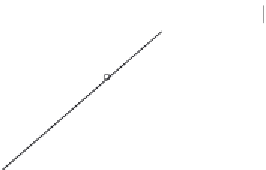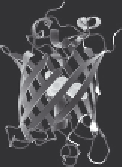Biology Reference
In-Depth Information
combination with state-of-the-art detection devices. In this review, we fo-
cus on the molecular bases of fluorescent proteins, fluorescent protein-based
biosensors, and methods to evaluate the signals from these sensors; we also
discuss their potential for use in translational research or clinical situations.
2. FLUORESCENT PROTEINS
2.1. Chromophore formation of GFP and its derivatives
GFP is 238 amino acids long (
27 kDa) and folds into a cylindrical caged
structure of 11
-barrel) surrounding an internal distorted helix
(
Fig. 8.1A
).
6
Protein folding provides the driving force for the formation
of a chromophore (composed of three amino acids at positions 65-67, see
Fig. 8.1B
) in the internal helix, correctly orienting crucial residues to cata-
lyze and direct chromophore synthesis pathways. The rigid
b
-sheets (
b
-barrel also
comprises the protein matrix surrounding the chromophore, which shields
it from the solvent and provides a chemically complex environment,
b
A
B
Ser65
Gly67
Folding
Tyr66
Gly67
Circularization
HO
N
O
O
O
N
C
N
N
H
N
H
H
O
O
O
HN
O
N
O
OH
HO
H
HO
Tyr66
Ser65
Ser65
N
OH
N
H
H
OH
OH
Dehydration
Oxidation
Tyr66
Gly67
O
O
C
N
N
+
H
N
O
O
800
F
12
= 0.5274
F
12
= 0.527
D
1
(
R
HO
HO
N
N
Ser65
2
= 0.9923)
H
H
OH
OH
D
D
1
F
12
F
12
-
a
12
D
1
400
0
0
500
1000
1500
Fluorescent intensity of
F
11
(
D
1
) (A.U.)
Figure 8.1 Basic properties of GFP. (A) Structure of Aequorea victoria GFP. Black balls
within the b-barrel indicate the chromophore, whereas the main chains of amino acids
from which circularly permutated GFPs are started are also highlighted. (B) Chemical
reaction leading to chromophore formation. (C) Correction of emission bleed-through.
Fluorescence intensities of D
1
obtained through the filter f
2
(F
12
) are plotted against
those obtained through f
1
(F
11
). (D) Typical photographs before (D
1
and F
12
) and after
(F
12
-
a
12
D
1
) correction are shown.












































































































































































Search WWH ::

Custom Search